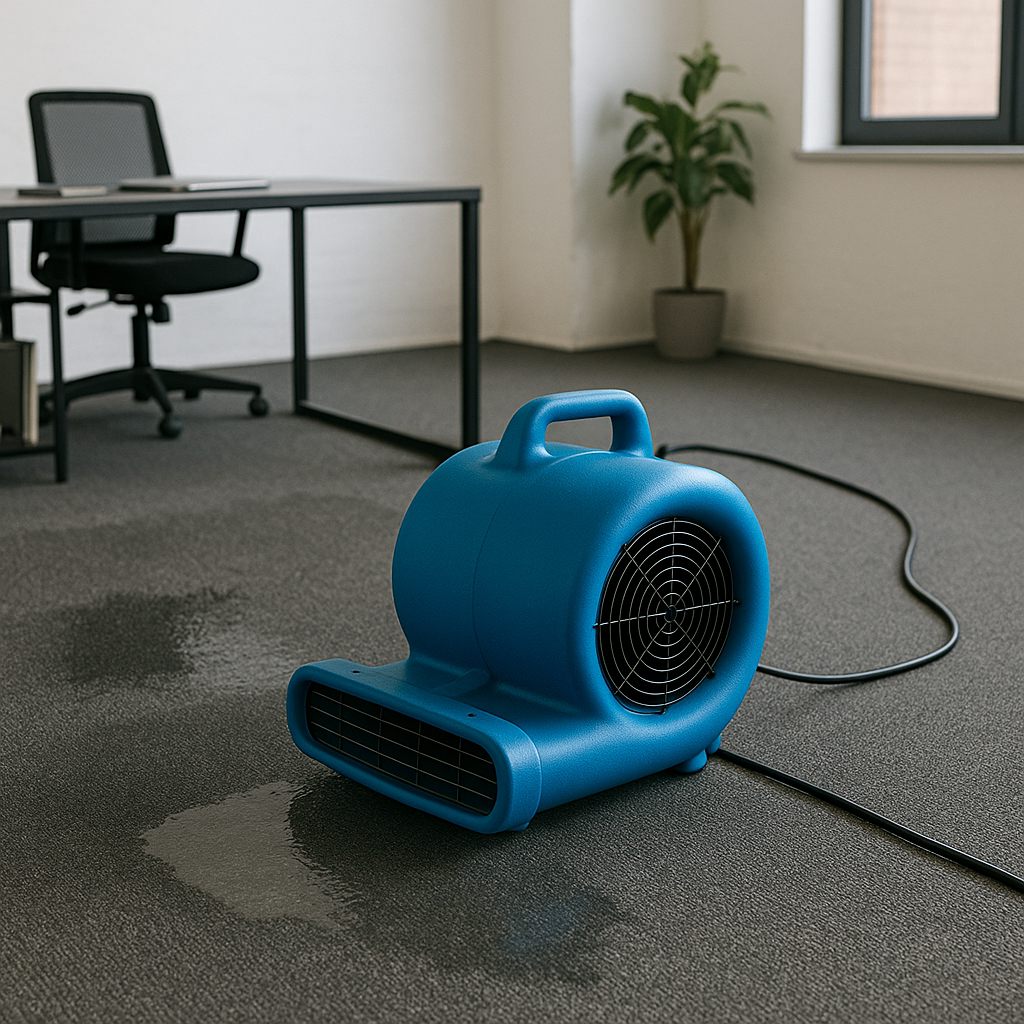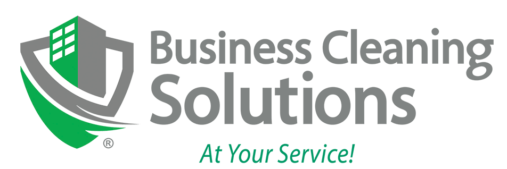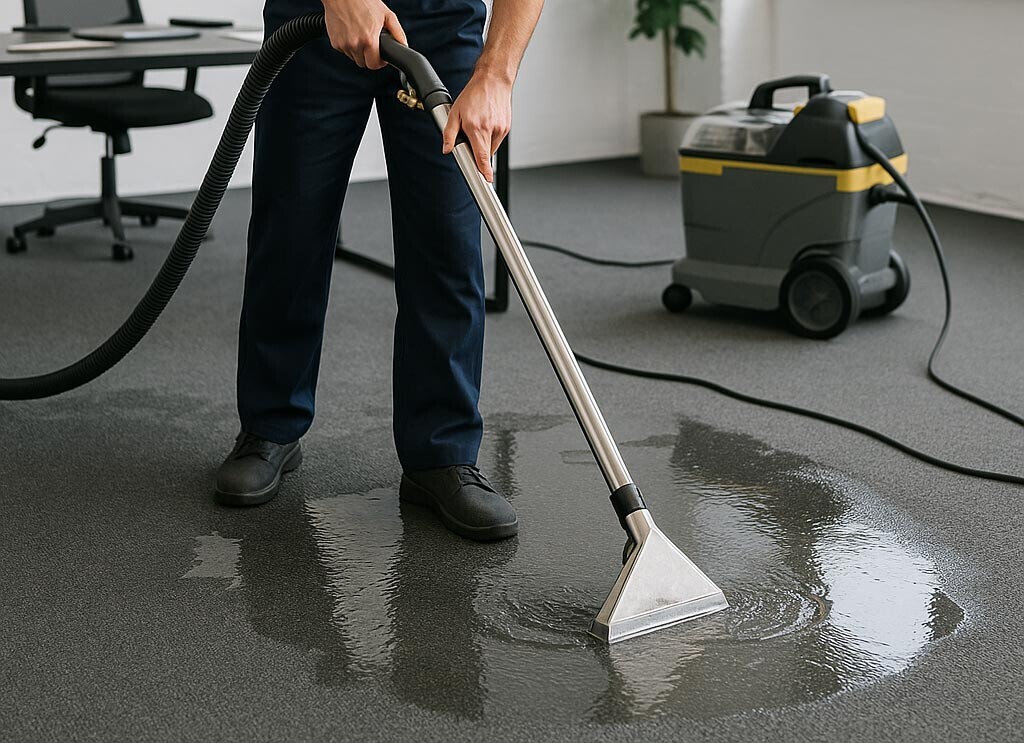Water damage is one of the most stressful situations businesses can face. A burst pipe, overflowing washing machine, or sudden flood can turn your carpeted floors into a soggy mess within minutes. Worse yet, if water isn’t removed quickly, it can lead to permanent carpet damage, foul odors, and dangerous mold growth.
At Business Cleaning Solutions we help our janitorial customers when a minor flood occurs by offering carpet water extraction, hot water extraction cleaning, deodorizing, and drying with air movers. But depending on the severity of the flood, your business might need professional restoration services from a restoration company for things like removing wet drywall, mold remediation, and carpet replacement.
In this comprehensive guide, we’ll walk you through everything you need to know about water-damaged carpet cleaning and mold in carpet from water damage prevention—from the critical emergency actions you should take in the first 24–48 hours to the signs that indicate when it’s time to call in a professional. We’ll also break down the DIY cleaning process, show you how to tell if a carpet is unsalvageable, and provide long-term strategies for preventing future damage.
Why Immediate Action Matters: The 24-48 Hour Window
When water saturates carpet, time is your biggest enemy. Within just 24 to 48 hours, moisture trapped in carpet fibers and padding creates the perfect breeding ground for mold and bacteria. The faster you act, the better chance you have of salvaging your carpet and avoiding costly replacement.
A quick response also reduces health risks. Mold spores, bacteria, and allergens thrive in damp conditions. Left untreated, water damage can lead to respiratory issues, skin irritation, and worsening allergies. This is especially true for mold in carpet from water damage, which can be hidden and difficult to remove without professional help. That’s why every water damage situation should start with a clear emergency action plan.
Emergency Action Plan for Water-Damaged Carpets
1. Prioritize Safety
Before you even think about your carpet, make sure the area is safe.
- Turn off electricity in affected rooms if water is standing. Water and electricity are a dangerous combination.
- Wear protective gear such as gloves, boots, and a mask, especially if the water source is questionable.
- Avoid slipping hazards—wet carpet can be surprisingly slick.
2. Assess the Water Source
Not all water damage is equal. The type of water involved determines how you should proceed.
- Clean Water (Category 1): Comes from a burst pipe, rainwater leak, or overflowing sink. If addressed quickly, carpets can often be salvaged.
- Gray Water (Category 2): From washing machines, dishwashers, or toilet overflows (without feces). Contains contaminants and requires thorough sanitization.
- Black Water (Category 3): From sewage backups, storm flooding, or groundwater. Highly contaminated with bacteria and pathogens—carpets usually must be replaced.
Rule of thumb: If black water is involved, it’s not safe to attempt DIY cleaning. Call professionals immediately.
3. Remove Excess Water
The first step in recovery is getting rid of as much water as possible.
- Use a wet/dry vacuum (never a household vacuum) to extract standing water.
- For large floods, professional-grade extraction is more effective. At Business Cleaning Solutions, we use powerful hot water extraction systems to pull out moisture from both the carpet and the padding beneath. This is a crucial step in preventing mold.

4. Move Furniture Off the Carpet
Water can cause wooden furniture to stain carpet fibers and metal legs to rust. Remove furniture immediately and place items on blocks or foil to prevent further damage.
DIY Water Damage Carpet Cleaning
For minor water damage from clean water sources, a DIY approach can be effective. Here’s how to tackle it step by step.
Equipment Checklist
- Wet/dry vacuum
- Fans (preferably high-powered air movers)
- Dehumidifier
- Baking soda or carpet-safe deodorizer
- Antimicrobial cleaner or disinfectant
- Protective gloves and mask
Step 1: Extract Water
Use your wet/dry vacuum to pull as much water as possible from the carpet. Press firmly and go over each section multiple times. If the padding underneath is saturated, it may need to be removed and replaced, as it’s nearly impossible to dry completely and can become a source of mold in carpet from water damage.
Step 2: Speed Up Drying
Moisture left behind is what leads to mold.
- Position fans or air movers to blow across the carpet surface.
- Run a dehumidifier in the room to pull moisture from the air.
- Open windows (if weather permits) to increase airflow.
At Business Cleaning Solutions, we bring in industrial-grade air movers that cut drying time dramatically compared to household fans, which is vital for preventing mold in carpet from water damage.
Step 3: Clean and Sanitize
Once the carpet feels dry, it’s time to clean it thoroughly.
- Use hot water extraction or steam cleaning to remove embedded dirt and contaminants.
- Apply an antimicrobial solution to kill bacteria in carpet and prevent mold growth.
- Sprinkle baking soda on the carpet, let it sit overnight, and vacuum it up for natural deodorization.
Our team provides professional deodorizing treatments to eliminate musty odors that DIY solutions sometimes can’t fully remove.
Step 4: Monitor for Mold
Even after drying and cleaning, keep an eye on your carpet for signs of trouble:
- Musty odors
- Visible dark spots or fuzzy growth
- Persistent dampness
If any of these signs appear, call a professional immediately.
When to Call a Professional Carpet Cleaner
DIY can work for small, clean-water spills, but there are many situations where professional help is the safer and more effective option.
DIY vs. Professional: A Quick Comparison
| Factor | DIY Cleaning | Professional Cleaning |
| Cost | Low upfront cost | Higher, but often covered by insurance |
| Equipment | Household-grade | Industrial-grade (air movers, hot water extraction, deodorizers) |
| Speed | Slower drying | Faster drying, mold prevention |
| Contamination | Limited ability to sanitize | We can kill bacteria in carpet, remove contaminants |
| Mold Risk | Higher | Lower due to thorough extraction and treatment |
Signs You Need Professional Help
- The water source is gray or black water.
- Standing water from floods needs to be extracted.
- Water has been present for more than 24–48 hours.
- Carpets smell musty even after drying.
- You see visible mold.
- The subfloor beneath the carpet is saturated.
At Business Cleaning Solutions, we handle the carpet cleaning, drying, deodorizing, and bacteria elimination—giving you peace of mind and preventing mold in carpet from water damage.
Note on Full Restoration
It’s important to clarify: while we handle carpet water extraction and cleaning, we do not provide:
- Drywall repair
- Demolition
- Mold remediation
- Full restoration services
For complete restoration, you’ll need a specialized restoration contractor.
Mold Prevention After Water Damage: A Proactive Approach
Mold can begin forming within 24 hours, so preventing it should be a top priority.
Risk Assessment
Mold thrives in damp, warm environments. Carpets with thick padding or high pile are especially vulnerable because moisture gets trapped deep inside, creating the perfect environment for mold in carpet from water damage.
Preventative Measures
- Dry carpets completely within 24–48 hours.
- Use an antimicrobial cleaner once the carpet is dry.
- Keep indoor humidity below 50% with dehumidifiers.
- Replace saturated carpet padding—it’s nearly impossible to dry fully and is a primary source of mold growth.
We use professional cleaning agents designed to kill bacteria in carpet and minimize mold risk.
Post-Cleanup and Long-Term Carpet Care
Once the emergency is over, it’s time to think about long-term recovery and prevention.
When to Replace vs. Restore
Sometimes, carpet can’t be saved. You should replace carpet if:
- Water has been present for more than 72 hours.
- Odors persist after thorough cleaning.
- Mold is visible or keeps returning.
- Black water contamination is involved.
Restretching the Carpet
Water damage can cause carpets to buckle or wrinkle. A professional can restretch the carpet to restore its appearance once it’s dry.
Future Prevention
Reduce your risk of future water damage with these steps:
- Inspect plumbing and appliances regularly.
- Install leak detection systems with automatic shut-offs.
- Ensure proper ventilation in areas prone to moisture.
- Schedule routine professional carpet cleaning to maintain carpet health.
Partner Highlight: Buk Restoration in Boise
If you’re located in the Boise area and need carpet water damage services, another trusted option is Buk Restoration. They provide restoration-focused solutions for severe water damage situations, including carpet cleanup and repair.
While Business Cleaning Solutions focuses on professional carpet cleaning, extraction, and drying, Buk Restoration offers a broader scope of restoration services for Boise residents.
Final Thoughts
Water damage is stressful, but the right action plan can save your carpets, protect your health, and prevent long-term costs.
- Act fast within the first 24–48 hours.
- Use DIY methods for minor, clean water spills.
- Call professionals for gray or black water, persistent odors, or large floods.
- Take mold prevention seriously.
At Business Cleaning Solutions, we provide expert hot water extraction, water extraction from floods, deodorizing, bacteria elimination, and air mover drying to restore water-damaged carpets safely and effectively.
Contact us today if your carpet has been damaged by water. The faster we act, the more we can save.


